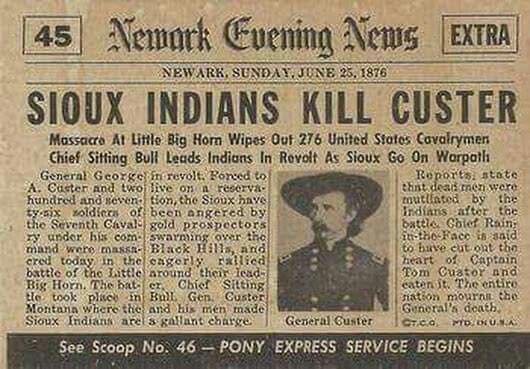
Details Native News Online Staff June 25, 2024
This day in history. Today is known as Victory Day to many Lakota, Cheyenne and Arapaho people.
On this day, June 25, 1876, the Lakota, Cheyenne, and Arapaho banded together and annihilated General George Armstrong Custer’s 7th Cavalry. Many people know this as General Custer’s Last Stand and refer to what happened that day as a massacre.
The Hunkpapa, Miniconjou, Itajipco, Oglala, and Sahiela Lakota tribes, along with the Cheyenne and Arapaho, fought and won against racism.
This was the only time an American flag was captured on Turtle Island, and it remains the property of the Lakota. Over the next few decades, General Custer and his troops came to be seen as iconic, even heroic, figures in American history.
Don’t miss out on the biggest stories and breaking news from Indian Country: Sign up to have our reports delivered directly to your inbox every weekday morning.
However, Native Americans have a completely different view of General Custer. General Custer was known to hunt down Native women, children, and elderly people, which was his tactic when pursuing an attacked camp. Tribal victories were used as a means to keep the tribes oppressed. The death of General Custer and his troops intensified efforts to forcibly relocate Native peoples to reservations.
Most of the declared “enemies” surrendered within a year of the battle, and the Black Hills were lost to the U.S. government without compensation. Mount Rushmore was to be built in the Black Hills, sacred ground to the Lakota people.
Some call it a massacre, others a victory.
Similar articlesCheyenne River Youth Project’s Youth Employment Trainee Initiative welcomes five Lakota youth this summer
‘Our vote makes a difference’ | Navajo Voters Coalition announces primary election date change
Montana Strengthens MMIP Task Force with New Appointments
National Native American Housing Conference Kicks Off 50th Anniversary; Tribal Leaders Urgently Call for Reauthorization of Native American Housing Act
Join us as we celebrate 100 years of Native American citizenship. On June 2, 1924, President Calvin Coolidge signed the Indian Citizenship Act, granting Native Americans U.S. citizenship. It was a landmark moment in their quest for equality. This year marks the 100th anniversary, and our special project, Heritage Unbound: Native American Citizenship at 100, looks back on their journey with stories of their struggles, struggles and triumphs. Your donation fuels efforts like this and ensures that our reporting and projects that honor Native American traditions thrive. Your donation fuels efforts like this and ensures that our reporting and projects that honor Native American traditions thrive.
About the Author

Author: Native News Online Staff Email: This email address is being protected from spambots. You need JavaScript enabled to view it.
Native News Online is one of the most-read publications covering Indian Country and news important to American Indians, Alaska Natives and other Indigenous peoples. [email protected].


